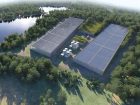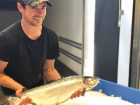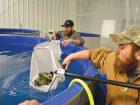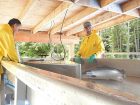
Features
Management
Profile
Research
Sustainability
RAS Roundup: Promises and Perils
The jury is still out on whether land-based Atlantic salmon farming will deliver on its promise of profitability, but intense media attention and industry interest in 2018 have made it all seem like a tipping point has been reached.
December 7, 2018 By Liza Mayer
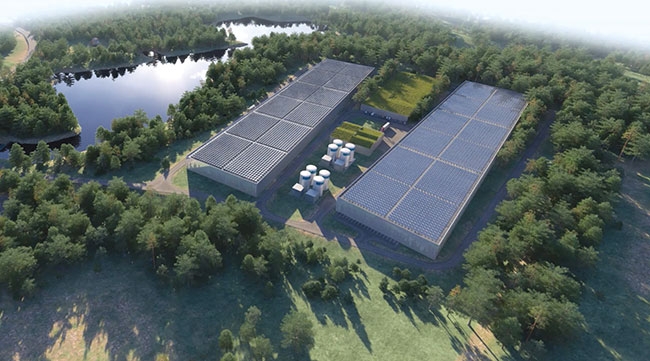 A rendering of Nordic Aquafarm's planned RAS facility in Belfast, Maine (Image: Nordic Aquafarms)
A rendering of Nordic Aquafarm's planned RAS facility in Belfast, Maine (Image: Nordic Aquafarms) The latest tally puts salmon grow-out projects around the world operating, or in various stages of construction, at roughly 30. Of this figure, the United States accounts for seven, Denmark five, Canada two (one of which is on hiatus), Norway and China three each, and the rest – nine – are scattered across the rest of the world.
Land-based aquaculture, powered by recirculating aquaculture systems (RAS), is nothing new in Atlantic salmon farming. It is a proven technology in smolt production. What’s innovative is using the technology in raising fish to market size (typically around 5 kg each) in land-based tanks instead of moving them in the second half of their lifecycle to mature in the ocean. This new “movement” has sparked industry debates, packed rooms in industry conferences with both curious participants and those wanting to learn more, and, judging by the number of projects underway around the world, has attracted big capital.
The big problem with RAS is not the lack of public support or investors; it is the lack of a success story demonstrating profitability. The problem has long been that RAS costs a lot of money. British Columbia-based Kuterra, much-publicized as the “first” in North America to farm Atlantic salmon entirely in a land-based facility (there were earlier attempts in B.C.), has ran out of money. Its backers, the Namgis First Nation, declared in 2017 it is “no longer in a position to carry the financial risk of the venture.” The farm suspended its operations in July 2018 for a “maintenance break,” while confirming it was still in exclusive talks with a potential investor to help it get the economies of scale it needs. What the purveyors found was that a land-based salmon farm needs to be scaled to produce at least 3,000 mt/year to yield investment-grade returns. Kuterra yielded 180 mt in its first year of operations in 2015; the plan is to scale it up initially to 300 mt and then to 1,500 mt, if it finds an investor.
Big bets
RAS projects currently under construction have much bigger ambitions. To name a few: Atlantic Sapphire in Miami expects to see an initial harvest of roughly 8,100 mt head-on gutted (HOG) salmon by the end of 2020, and that includes at least 2,000 mt from its Danish operations. This will ramp up to 90,000 mt/year at full capacity in 2026. Nordic Aquafarms in Maine will have the capacity of producing 33,000 mt/year once fully completed, while Whole World Oceans, also in Maine, hopes to see 50,000 mt/year of combined production at several planned facilities in the state.
But the question remains: will land-based aquaculture deliver?
“To date I don’t know of any salmon RAS anywhere in the world that’s attained steady-state profitable production,” Steve Atkinson, president of Taste of BC Aquafarms in Nanaimo, B.C., tells RASTech. “That’s not there yet. We’re very close, there are several others that are close, and there are some who are producing pro forma budgets to say that it can be successful. But is there anybody today that’s showing a profit? I don’t believe there is.” Taste of BC Aquafarms raises steelhead salmon at its Little Cedar Falls land-based fish farm.
Wisconsin-based Superior Fresh made history in July 2018 by becoming the first commercial-scale land-based aquaculture facility in the United States to bring RAS Atlantic salmon to market. Its first harvest yielded 2,000 lbs (less than 1 mt) HOG Atlantic salmon in June.
Event this triumph was not spared from skepticism, however. “A lot of people have produced Atlantic salmon in RAS systems but to date none have been financially viable,” says Brad Hicks, an experienced net pen farmer who installed the first RAS salmon system in B.C. 23 years ago. “All the hype about RAS so far has been about raising money. Very little raising of fish.”
The BC advantage
Entrepreneurs behind BC LandAqua Ventures Inc., an aquaculture park being planned on Vancouver Island, B.C., strongly believe in RAS aquaculture and the province’s potential to become a major land-based salmon producing region.
“Many of the operations that critics point to as failures are historic; [they were] using early versions of technology,” says BC LandAqua Ventures spokeswoman Josephine Mrozewski. “The new-generation technology has developed so quickly, and the land-based industry developing quickly along with it, that it’s simply not relevant to make these historic comparisons. Any industry based on new technology goes through several stages, starting with basic science, then to applied science and R&D, then small-scale proof-of-concept pilots, and finally full-scale commercial implementation.” (See side bar: RAS technology: same dog, different collar?)
Mrozewski expresses concern that B.C., which already has a fully developed seafood industry ecosystem, could miss the boat in this field.
“B.C.’s window to become the centre of salmon supply for the whole Pacific Rim market is to leverage its advantages before U.S., investors have a chance to look to the Pacific Coast for land-based operations,” Mrozewski says.
“Its advantages – expertise, infrastructure and proximity to the Pacific Coast market – mean B.C., can move quickly to establish a land-based industry before areas without the infrastructure, such as the U.S. west coast, can catch up. Most of the U.S. west coast does not have this expertise or all these elements of the value chain.”
The International Salmon Farmers Association report, The Evolution of Land-Based Atlantic Salmon Farms, notes the limitations of such a massive endeavor. “Even if it were technically and economically feasible, and if enough coastal land and water were available, the current production in Canada alone would require 28,000 football fields, 33,719 acres, or 136 square kilometers of land to grow fish in appropriate densities and water depths in land-based systems,” the report states.
John Paul Fraser, executive director of the BC Salmon Farmers Association (BCSFA) believes moving B.C.’s salmon industry to land-based facilities – as some conservationists are pushing for – will effectively shut down the industry.
“I don’t think the limitations of land-based aquaculture are fully understood,” Fraser tells RASTech. “The environmental implications and the costs and the challenges of having to pave over 136,000 square kilometers of land and the four billion liters of freshwater that we would need, and the massive amount of electricity to oxygenate the water, and replicate those conditions. It’s just a massive enterprise,” he says.
“I think as the technology evolves, it’s possible that land-based aquaculture can take on a larger role in helping provide this really healthy important food,” Fraser adds. “But it’s not ‘instead of’ ocean-based aquaculture, it’s ‘in addition to’, and I think we need both. That’s really the message that I’m trying to get out.”
Brad Hicks, a net pen farmer, says Canada’s advantages lie in net pen operations. “Norway, Chile, Scotland and Canada have a clear advantage for net pen operations,” Hicks says. “Parts of the United States, Russia and China still have opportunities to grow some salmon in net pens. None of these regions have any clear advantages for RAS. Should RAS be successful enough to competitively displace the supply of salmon coming from net pens, net pens will be out of the salmon business.”
But Hicks adds, “this will not happen anytime soon. There are currently 2.4 million tonnes of profitable net pen salmon in the market compared to two to four thousand tonnes of money-losing RAS salmon operations. RAS has a very long way to go and massive capital requirements to get there.”
Samuel Chen, who helped steer his family’s Hudson Valley Fish Farms in Albany, N.Y., from conceptual stage to the first three crops of RAS steelhead, points out good reasons why there’s building frenzy in the United States, and not in B.C.
“I think it’s precisely because there is an established industry of net pen farming in B.C., and around Canada that makes it less likely for the development of RAS projects,” says Chen, who is now a B.C.-based industry consultant. “Because existing players have already adopted a certain technology that they have been using, there is both economic and operational considerations that make it less likely to adopt other technology.”
Chen believes it’s likely going to be new players or players who are expanding in new markets that will try new technologies.
“There is a parallel in the movie theater business and dental offices being built in developing countries,” Chen explains. “You’ll see more movie theaters in those countries with the most-up-to-date projectors and sound systems, or more dental offices with lasers (than in an already mature market). So in Canada, or somewhere like Norway, it’s more likely that you’ll see RAS used to expand smolt facilities in support of their existing net-pen operations.”
Atkinson believes the future in RAS salmon farming lies in building small- to medium-sized farms with capacity of 100 to 400 tonnes. “RAS as a replacement for net-cage salmon culture is a discussion that’s very different than the discussion that I want to have,” he says.
“My suggestion is that we start with two 100-ton modules and grow that ability to grow up to 1,000-tonne with that kind of design. I looked at how the salmon industry in B.C., started; it started in 1980s with 100-tonne farms, family, small business farms. Many of them failed, a few of them succeeded,” Atkinson continues. “Successful ones bought out some of the losers, and by trial and error it led to the development of an industry. Small successes became bigger successes. That’s how you build an industry.”
Print this page
